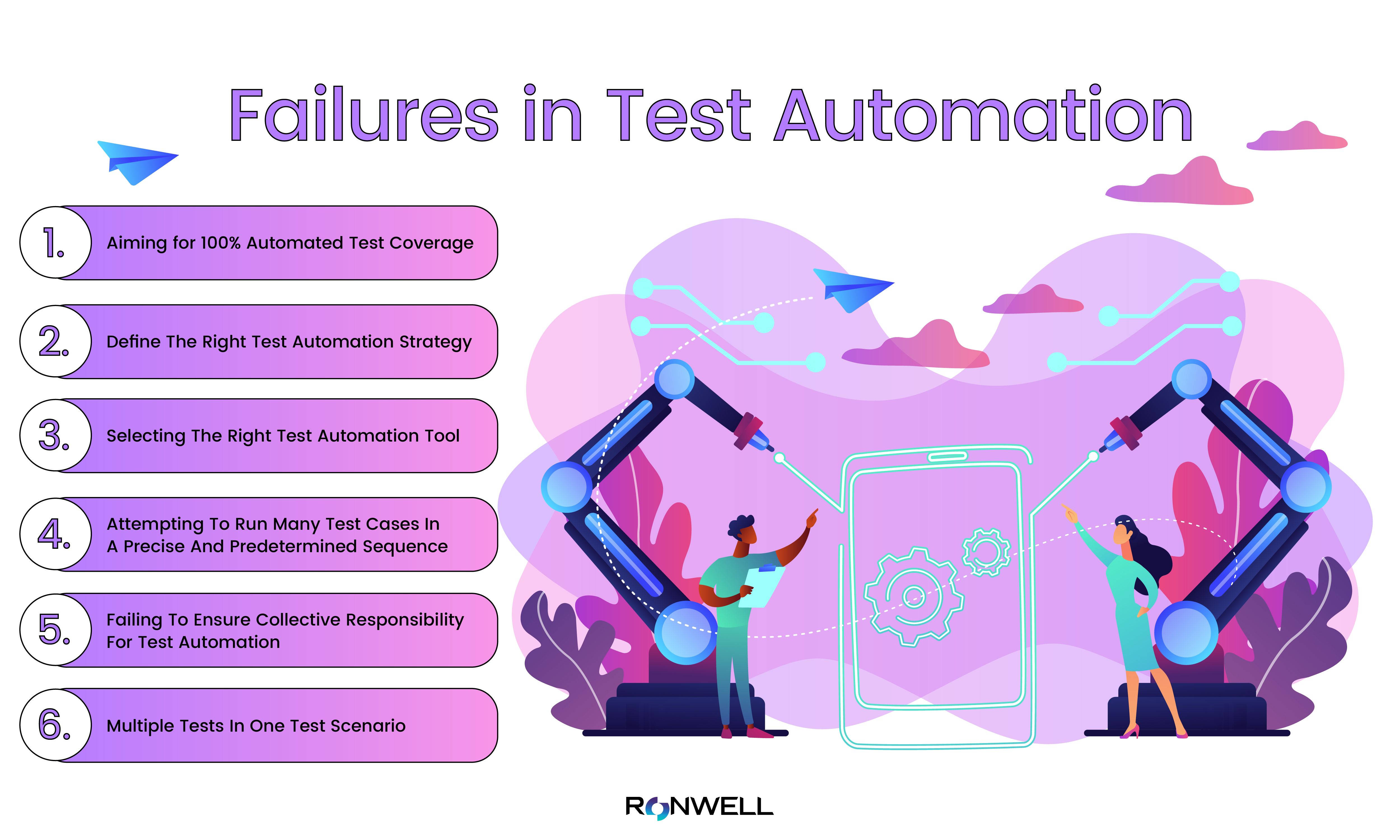

Our Services
Test Automation ServicesAI & Machine LearningBlockchainCRM ConsultingData Science & EngineeringDevOpsDigital MarketingDigital TransformationEmbedded Software DevelopmentERP Consulting ServicesManaged IT ServicesMergers & Acquisitions AdvisoryQA And Testing ServicesRobotic Process Automation SAP Consulting DevelopmentSoftware and Application DevelopmentSQL ConsultingStrategy ConsultingSustainability
- Contact Us
Our Services
- Test Automation Services
- AI & Machine Learning
- Blockchain
- CRM Consulting
- Data Science & Engineering
- DevOps
- Digital Marketing
- Digital Transformation
- Embedded Software Development
- ERP Consulting Services
- Managed IT Services
- Mergers & Acquisitions Advisory
- QA And Testing Services
- Robotic Process Automation
- SAP Consulting Development
- Software and Application Development
- SQL Consulting
- Strategy Consulting
- Sustainability
Insight
Company
Industries
- Contact Us

5 Failures in Test Automation: Best Practices for Dealing with Them
This blog article will cover testers' most common test automation failures and solutions to those challenges.
- insight
- /
- blog
- /
- failures-in-test-automation-and-best-practices-for-dealing-with-them
The increased popularity of test automation may be attributed to the necessity of high-quality software delivered in a shorter amount of time for firms to remain competitive in the modern market. Businesses in various sectors use test automation to save time and resources by eliminating manual processes and providing their customers with better quality and more frequent software updates.
Read also: Top 12 Benefits of Test Automation.
However, test automation often fails because of testers' frequent errors, which negatively affects ROI for businesses. The good news is that, in most circumstances, these faults are entirely preventable.
This blog article will cover the most common test automation failures that testers face and solutions to those challenges.

Aiming for 100% Automated Test Coverage
Keep in mind that fully automated testing is not what test automation entails. Freeing up time for manual testing, such as that required for unstable features, exploratory testing, etc., is a significant advantage of test automation. This means that testers should focus their efforts on where they will have the most significant impact. While it's true that test coverage cannot be increased to 100% with automation alone, we've found that teams can get quite close by using automation to test the user interface.
To learn more about manual and automation testing: Manual Testing vs. Automation Testing.
It is recommended that you gradually automate your test suite. We suggest that you start by automating the flows that are easiest to do. Most of the time, the flows that take the most time to test are the ones that are simple and do the same thing over and over again.
Define The Right Test Automation Strategy
It's tempting to develop lists of tasks to automate, followed by a search for appropriate software. According to Bas Dijkstra, a consultant in the field of test automation, there is a prerequisite to this. Teams sometimes rush toward automating processes without asking, “Why are we automating this?”
As a first step toward error prevention, you should ask yourself, "What risk are we seeking to manage with our test?" and “How does automation aid that?”
Learn more about Test Automation Strategy: Importance, Benefits & Example.
The solution is to clearly define each automation initiative's intended outcomes and milestones, keeping in mind that all potential areas of automation should contribute to "quality at speed" in some quantifiable way.
Selecting The Right Test Automation Tool
Make sure the test automation platform you choose supports your technical needs before committing to it. This includes installing the tool in your environment and letting potential users test it with your own software.
People often make the mistake of choosing a tool based only on their current problems and automation goals. This comes with the risk that your organization will be stuck with a tool that isn't an excellent technical fit in the long run.
Read our article to learn more about the Top 20 Automation Testing Tools.
Implementing test automation is a strategic decision that should be considered a long-term investment. When deciding which automation solutions to use, it's essential to take a company-wide view and catalog all the software and hardware that could be automated.
Consider whether your test cases will ever need to switch between different technologies (such as online and desktop apps) and pick an automation platform accordingly.
Attempting To Run Many Test Cases In A Precise And Predetermined Sequence
There should be a single purpose for each test case. Each test case should be able to be executed independently of the others, and it should not matter in what order the instances are performed in accordance with the "atomic" concept of testing.
Since re-testing a whole suite of hundreds of tests can be time-consuming and inefficient if a single test case fails, it's crucial to ensure that your suite can be performed in any order. Once again, physical scrutiny is required to find the mistake, and we can all see how inefficient this is.
Some test teams approach the development and scheduling of automated test cases with the idea that they constitute a sequence to be run in a particular order. This strategy undermines the adaptability, speed, and other advantages of automated testing.
Create automated test cases that are fully functional on their own. This approach can prepare them for simultaneous execution in several settings.
Read Also: What is Automation Testing? Types, Examples, Process.
Failing To Ensure Collective Responsibility For Test Automation
There's always the chance that using a new automation solution will require excessive time and effort from you and your team to overcome any unforeseen learning curves or technical hurdles. Because of this, testers must spend less time on their jobs (building test cases, analyzing requirements, reporting, etc.).
Recommended Reading: Test Automation Framework: Benefits, Types & How to Choose
Since most automation technologies require programming skills, teams that rely on them have a greater chasm between their "technical" testers and their "non-technical" colleagues. Test automation is typically delegated to the technical team members, with little to no buy-in from other team members.
This split on a team can lead to several problems:
- If only a small subset of the team has access to automation, only those individuals can comprehend, manage, and evaluate the automated test cases and outcomes.
- When the people responsible for automating tasks leave their jobs, they take new test cases. It will therefore be necessary to schedule a time to recreate these test instances.
- There is a danger of leaving out testers with highly specialized subject expertise if only "technical" testers are allowed to work with automated tests. These individuals deeply understand the tested application and may offer helpful feedback while test cases are being automated.
Most effective method: Keep in mind that the expertise of your entire staff is crucial to automating tasks. Use a standardized platform for test automation that can be learned by all testers, making automation an integral part of the routine for everyone on the team.
Bonus: Multiple Tests In One Test Scenario
There are often several ways a test case might fail if it is designed to validate various facets. Because of this, if a test case fails, it must be examined by hand to see what went wrong.
The best way to create test cases is to ensure that each focuses on testing one specific feature. In this manner, when a test case fails, it is immediately clear what went wrong.
If you are using a test automation tool, it's preferable not to combine several tests into a single instance but rather to create modular parts that may be reused in other contexts. In this method, the effort spent developing a new test case may be kept to a minimum while maximizing the reusability of previously developed test case logic.
Read our guide: How to Learn Automation Testing: 22 Free Online Courses.
Writer:

Halime Yılmaz
Content Marketing Specialist
6 min read
15 December 2022, Thursday
Related Posts
Related Industries
Related Services






